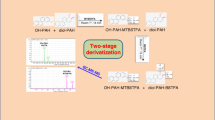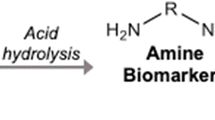Abstract
Styrene is one of the most important industrial chemicals, with an enormously high production volume worldwide. The urinary mercapturic acids of its metabolite styrene-7,8-oxide, namely N-acetyl-S-(2-hydroxy-1-phenylethyl)-l-cysteine (PHEMA 1) and N-acetyl-S-(2-hydroxy-2-phenylethyl)-l-cysteine (PHEMA 2), are specific biomarkers for the determination of individual internal exposure to this highly reactive intermediate of styrene. We have developed and validated a fast, specific and very sensitive method for the accurate determination of the sum of phenylhydroxyethyl mercapturic acids (PHEMAs) in human urine with an automated multidimensional liquid chromatography–tandem mass spectrometry method using 13C6-labelled PHEMAs as internal standards. Analytes were stripped from the urinary matrix by online extraction on a restricted access material, transferred to the analytical column and subsequently determined by tandem mass spectrometry. The limit of quantification (LOQ) for the sum of PHEMAs was 0.3 μg/L urine and allowed us to quantify the background exposure of the (smoking) general population. Precision within series and between series ranged from 1.5 to 6.8% at three concentrations ranging from 3 to 30 μg/L urine; the mean accuracy was between 104 and 110%. We applied the method to spot urine samples from 40 subjects of the general population with no known occupational exposure to styrene. The median levels (range) for the sum of PHEMAs in urine of non-smokers (n = 22) were less than 0.3 μg/L (less than 0.3 to 1.1 μg/L), whereas in urine of smokers (n = 18), the median levels were 0.46 μg/L (less than 0.3 to 2.8 μg/L). Smokers showed a significantly higher excretion of the sum of PHEMAs (p = 0.02). Owing to its automation and high sensitivity, our method is well suited for application in occupational or environmental studies.





Similar content being viewed by others
References
Miller RR, Newhook R, Poole A (1994) Crit Rev Toxicol 24(Suppl):S1–S10
Cruzan G, Cushman JR, Andrews LS, Granville GC, Johnson KA, Bevan C, Hardy CJ, Coombs DW, Mullins PA, Brown WR (2001) J Appl Toxicol 21:185–198
Dypbukt JM, Costa LG, Manzo L, Orrenius S, Nicotera P (1992) Carcinogenesis 13:417–424
Vodicka P, Tvrdik T, Ostermann-Golkar S, Vodickova L, Peterkova K, Soucek P, Sarmanova J, Farmer PB, Granath F, Lambert B, Hemminki K (1999) Mutat Res 445:205–224
Fracasso ME, Doria D, Carrieri M, Bartolucci GB, Quintavalle S, De Rosa E (2009) Toxicol Lett 185:9–15
IARC (2002) IARC Monogr Eval Carcinog Risks Hum 82:437–550
Campagna D, Gobba F, Mergler D, Moreau T, Galassi C, Cavalleri A, Huel G (1996) Neurotoxicology 17:367–373
Sliwinska-Kowalska M, Zamyslowska-Szmytke E, Szymczak W, Kotylo P, Fiszer M, Wesolowski W, Pawlaczyk-Luszczynska M, Bak M, Gajda-Szadkowska A (2003) J Occup Environ Med 45:15–24
IARC (1994) IARC Monogr Eval Carcinog Risks Hum 60:321–346
Deutsche Forschungsgemeinschaft (2009) List of MAK- and BAT-values 2009. Wiley-VCH, Weinheim
Byrd GD, Fowler KW, Hicks RD, Lovette ME, Borgerding MF (1990) J Chromatogr 503:359–368
Darall KG, Figgins JA, Brown RD, Phillips GF (1998) Analyst 123:1095–1101
Adgate JL, Eberly LE, Stroebel C, Pellizzari ED, Sexton K (2004) J Expos Anal Environ Epidemiol 14(Suppl 1):S4–S13
Kim YM, Harrad S, Harrison RM (2001) Environ Sci Technol 35:997–1004
Lee SC, Lam S, Fai HK (2001) Build Environ 36:837–842
Brooks SM, Anderson L, Emmett E, Carson A, Tsay JY, Elia V, Buncher R, Karbowsky R (1980) Arch Environ Health 35:287–294
Nakajima T, Elovaara E, Gonzalez FJ, Gelboin HV, Raunio H, Pelkonen O, Vainio H, Aoyama T (1994) Chem Res Toxicol 7:891–896
Haufroid V, Jakubowski M, Janasik B, Ligocka D, Buchet JP, Bergamaschi E, Manini P, Mutti A, Ghittori S, Arand M, Hangen N, Oesch F, Hirvonen A, Lison D (2002) Pharmacogenetics 12:691–702
Norström A, Löf A, Aringer L, Samuelsson R, Andersson B, Levin JO, Näslund P (1992) Chemosphere 24:1553–1561
Seutter-Berlage F, Delbressine LP, Smeets FL, Ketelaars HC (1978) Xenobiotica 8:413–418
Boettcher MI, Angerer J (2005) J Chromatogr B Anal Technol Biomed Life Sci 824:283–294
Kellert M, Scholz K, Wagner S, Dekant W, Völkel W (2006) J Chromatogr A 1131:58–66
Kopp EK, Sieber M, Kellert M, Dekant W (2008) J Agric Food Chem 56:9828–9834
Scholz K, Dekant W, Völkel W, Pähler A (2005) J Am Soc Mass Spectrom 16:1976–1984
Hecht SS, Villalta PW, Hochalter JB (2008) Carcinogenesis 29:937–943
Moriwaki H, Tsujimoto Y, Noda T, Shimizu M, Tanaka M (2000) Analyst 125:715–718
Urban M, Gilch G, Schepers G, van Miert E, Scherer G (2003) J Chromatogr B Anal Technol Biomed Life Sci 796:131–140
Haufroid V, Lison D (2005) Int Arch Occup Environ Health 78:343–354
Hallier E, Goergens HW, Karels H, Golka K (1995) Arch Toxicol 69:300–305
Maestri L, Imbriani M, Ghittori S, Capodaglio E, Gobba F, Cavalleri A (1997) Sci Total Environ 199:13–22
Manini P, Andreoli R, Bergamaschi E, De Palma G, Mutti M, Niessen WMA (2000) Rapid Commun Mass Spectrom 14:2055–2060
Fustinoni S, Campo L, Manini P, Buratti M, Waidyanatha S, De Palma G, Mutti A, Foa V, Colombi A, Rappaport SM (2008) Biomarkers 13:560–578
Larsen K (1972) Clin Chim Acta 41:209–217
Xu X, Iba MM, Weisel CP (2004) Clin Chem 50:2323–2330
Schettgen T, Musiol A, Alt A, Kraus T (2008) J Chromatogr B 863:283–292
Schettgen T, Musiol A, Alt A, Ochsmann E, Kraus T (2009) Anal Bioanal Chem 393:969–981
Manini P, Andreoli R, Mutti A (2006) Toxicol Lett 162:202–210
Acknowledgement
The authors would like to thank Kerstin Gerards for her skilful analysis of urinary creatinine.
Author information
Authors and Affiliations
Corresponding author
Rights and permissions
About this article
Cite this article
Reska, M., Ochsmann, E., Kraus, T. et al. Accurate quantification of mercapturic acids of styrene (PHEMAs) in human urine with direct sample injection using automated column-switching high-performance liquid chromatography coupled with tandem mass spectrometry. Anal Bioanal Chem 397, 3563–3574 (2010). https://doi.org/10.1007/s00216-010-3893-3
Received:
Revised:
Accepted:
Published:
Issue Date:
DOI: https://doi.org/10.1007/s00216-010-3893-3




